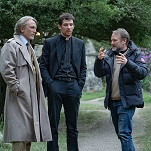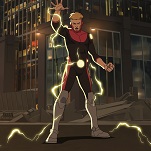The Devil’s Advocate
This week, our resident art history buff, Nick Wanserski, dug up Dante’s Inferno—you know, Visceral Games’ 2010 video game adaptation of the most EXTREME cantica in Dante Alighieri’s epic poem—for an aesthetic analysis that compared it to Gustave Doré’s famous 19th century woodblock illustrations of the same classic text. The game was, and is, widely derided for a number of reasons—its similarities to the God Of War games, its comically sleazy marketing campaign, its very existence—but CedricTheOwl defended its story with a lengthy, close reading:
In the interest of full disclosure, I should mention that I have a friend from college who worked on development for this game.
Dante’s Inferno is my favorite work of literature, and yet I really liked this game. I was all set to hate it when it was first announced, but I found a lot to like about it. I would be more than happy to dismiss the game were it not for the surprising amount of effort put into the story. The poem is a story about recognizing and overcoming the wrongs one commits in life; the game is that same theme applied to a single character. The game’s Dante is a supremely self-righteous zealot who gradually comes to terms with his own awfulness. The first few bosses are historical or fictional characters associated with those levels of Hell, mostly lifted directly from the poem. But once Dante passes through Greed, the boss fights take on a more personal nature.
In Greed, he fights his father, a supremely grotesque human being from which Dante learned his selfish ways. In Sadness, he fights his mother, now a suicide tree after killing herself in despair over her husband’s wickedness. In Anger, he fights Francesco, his best friend and Beatrice’s brother, who took the blame for Dante’s crimes in the Crusade and paid for it with his life. In Fraud, he finally confronts Beatrice, now a vengeful shadow of her former self after Dante’s unfaithfulness cost her life and her soul.
In all cases, Dante recognizes his own culpability in his sins, resisting the urge to cast the blame on someone else. He recognizes that his father may have been a terrible influence, but in the end, Dante’s decisions were his own and cannot be blamed on him. He might resent his mother for seemingly leaving him at the mercy of his father, but he does not blame her for what he became either. With Francesco, he recognizes that blaming the corrupt Church officials that urged him toward his crimes in the Crusades is no excuse for ignoring his own moral compass, and he accepts responsibility for the damnation of Francesco and the crusaders under his command. When he finally faces Beatrice, he has fully recognized his own awfulness and can do nothing but beg her forgiveness for what he’s done. For what it’s worth, I felt like the writers really nailed the theme of recognizing and triumphing over ones sins, which is the entire reason why it’s called the Divine Comedy.
Elsewhere, Suckerfish smartly points out how Dante’s Inferno is representative of a very specific era in recent gaming history that we’ve already moved away from:
This was the kind of thing you could get away with in 2010. Nowadays, if I heard about someone making a video game based on The Divine Comedy, particularly Inferno, I’d assume it stays close to its source material and has you actually walking through the different layers of hell and conversing with famous sinner. That actually sounds pretty awesome, now that I think about it. I would love to see a three-mouthed six-eyed weeping frozen Satan chowing down on Brutus, Cassius, and Judas.
Fluka had to wonder why it is that brutish games like this one have largely disappeared:
I wonder what changed in the past five years that made games like this suddenly seem so ridiculous and, more importantly, financially unviable. Was it the user base gradually getting older? (See also: the increasing number of games about dads.) The ever more realistic graphics creating a stylistic dissonance with this kind of teenage-boy-binder shlock? The decline of Jack-Thompson-style violent-video game panic and the acceptance of games as an actual artistic medium? With the absence of an existential threat, maybe game makers started moving toward more artistically interesting with games, rather than being all “Teehee, we’re naughty!” Maybe it was the rise of serious indie games? I suspect it’s a combination of all those factors.
Also Inferno definitely is a pretty stark example of the “old” stereotype of video games. See also the marketing campaign for the game, which alone pretty much justifies a half-decade’s worth of “the video game industry is shitty toward women” articles.
In his analysis of the game, Nick argued that it gets pretty weird—but not weird enough to justify the whole affair. As caindevera pointed out, it might have been even weirder if the studio had hewn more closely to the concept art it commissioned from artist Wayne Barlowe:
The developers also hired the great Wayne Barlowe to do concept art, on the strength of his Barlowe’s Inferno work, and then didn’t even use any of it other than his design for Charon. As a Barlowe fan, that was especially disappointing. Playing through a level based on some of this art might have been more interesting than what was actually released. You can kind of see how EA got to the Lucifer and Charon that appears in the game. The weirdness is just watered down, and honestly, they are not the best Barlowe designs, even compared to his other Inferno work.
I think the most important thing to note here is that Barlowe’s original design for Satan didn’t include a giant, exposed penis. You can thank Visceral for that.
ProTip
Alex McCown’s quest to not suck at first-person shooters continued this week in the second installment of our Shooter Tutor series. Notably, this was the first entry to include some footage of Alex’s play style, and those who’ve been following along got a real taste of just how hapless he is. There have been plenty of helpful tips and words of encouragement left in the comments over the last two weeks. Sandler’s List offered some great advice that can be applied to any game you’re having trouble with:
If I could offer a tip for a novice player, gleaned from my own experiences getting into games whose mechanics were alien to me, it’d be this: Make your deaths count. The actual mechanical skills of controlling the game will come in time, and there’s almost nothing you can do to speed up that process. So go ahead and use that time to cultivate a sense of mindfulness. Instead of focusing on staying alive, focus on understanding why you died. When you get killed, actually take a moment to identify the one specific thing that got you killed—you didn’t use the best weapon for the situation, or your clip ran out sooner than you thought it would, or you forgot to keep an eye on your health, or you stayed behind cover for too long, or ran into an open area where you were uncovered for too long, whatever. Just try to pinpoint the one main thing you did wrong, acknowledge it, and try again.
Make a point to experiment. Try different things to see if they work or, if they don’t, why not. Be very deliberate when you play; try to recognize all the little decisions that go into playing and make as many of them conscious decisions as possible. If you die because you took too long to decide which weapon to equip or you couldn’t remember which button throws a grenade, great. Just notice that that’s why you died, and restart.
You’ll find that over time, you start to internalize a lot of this stuff. You phase out your common mistakes, you get quicker in your decision-making, and it starts to become more natural to maintain presence of mind even when things are chaotic onscreen. When your facility with the controls catches up in its own time, you will be an unstoppable badass. It will startle you how good you suddenly are.
And that’ll do it for this week! As always, thanks for reading and commenting, Gameologerinos. We’ll see you next week.







































